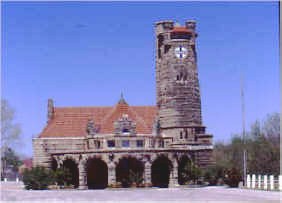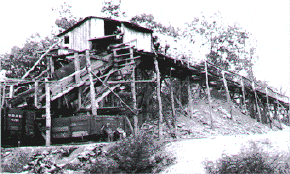The Wild West: 1865 to 1888
- Reconstruction, Railroads and Economic Development
- A Lawless Era and Cattle Drives
- Rodeos and Wild West Shows
- The Destruction of the Plains Tribes

Reconstruction, Railroads and Economic Development
|
Reconstruction following the Civil War began during a difficult time in Indian
Territory. First, the area was devastated due to the massive destruction during the
war. Armies fighting each other destroyed plantations, farms, homes and many entire
villages. Plus, each tribe lost about one-fourth of its population during the conflict.
Surviving Indian civilians were scattered everywhere. About 19,000 were homeless. Many of
them filled up two Union refugee camps. One camp was in southern Kansas and the
other one was near Ft. Gibson. Others were in a Confederate refugee camp in North Texas
just south of the Red River. The camps were horrible. Too many people were packed together
in a small space. Army officers did not give enough supplies to the refugees. Some people
starved to death. Epidemic diseases that swept through each camp also killed many
people.
The Union government dealt harshly with the Five Civilized Tribes. The excuse was that some elements of
each tribe had supported the Confederacy. In addition, the federal
government needed reservation land onto which to force the plains Indians. Their nomadic
days were about to end. American leaders and the chiefs of the Civilized Tribes met at the
Fort Smith Council in the fall of 1865. After negotiations failed, another council was
held in Washington, D.C. in 1866 where the Reconstruction treaties were signed.
The
Civilized Tribes lost their claim to western Oklahoma. The tribes had to agree to allow
railroads to pass through their territories. They had to accept their ex-slaves,
known as
Freedmen, as tribal
citizens, a requirement that many Indians resisted. Most blacks began farming on their own
in various parts of eastern Oklahoma. They founded a number of
all-black
towns. The year
1866 marked the beginning of the end for Indian Oklahoma. Whites would come to have much
more influence, especially in the 1870s, as the railroads came through Oklahoma.
|
Beginning in the early 1870s, the railroads became most
important to the economy of Oklahoma. The "Iron Horse" helped open the
region to the outside world. At the same time, those ribbons of rails helped open the
outside world to Sooner country. The first railroad to build through Oklahoma was the
Missouri-Kansas-Texas (1870-1872). It was called The
Katy. It followed the old Texas Road and ran through Choctaw, Creek and
Cherokee country. The Santa Fe Railroad was also important. It ran north-south through the
middle of Oklahoma. Other lines included the St. Louis & San Francisco, which cut
through the Choctaw Nation running southwesterly, and the Chicago Rock Island &
Pacific Railroad, which was west of the Santa Fe and ran north-south. |

Historic Santa Fe Train Depot in Shawnee (Photo Courtesy of Fred Marvel, Oklahoma Department of Tourism) |
Because of rail development, Oklahoma products such as beef, pork, cotton, corn and
wheat could reach the national markets. Also, the goods produced by the rest of the nation
could reach the Oklahoma market. Immigrants form the east and Europe in search
of a better life could also travel more easily to Oklahoma. In addition, the Iron Horse sped the growth of
the coal mining industry.
James J. McAlester from Arkansas learned of the coal beds in the
Choctaw Nation. He moved to the crossroads where the Texas and California trails
met. He established a store there in the heart of the area’s coal beds. He married
into the Chickasaw Nation. That made him a citizen of the tribe. As a citizen he could
have as much coal as he could mine. In 1872, The Katy reached his store. He sold his first
coal to The Katy. He then used the railway to ship coal to all points east of the
Mississippi River, shipping especially to eastern factories.
| A settlement grew up around his coal mine. It developed into today’s
city of McAlester. Later, other businessmen went into the coal business. The industry
became one of the biggest in Oklahoma. The Katy, itself, became involved in coal mining.
The railroad bought the Osage Mining and Coal Company. Because of the coal mines,
Oklahoma population became more diverse. Most coal miners recruited by the
companies came from outside the region. Italians, Russians, Poles, Germans and other
European immigrants worked in the mines. These immigrants accounted for
two-thirds of all the coal miners in Oklahoma. |

The Hailey-Ola Coal Company in Pittsburg County
(Photo courtesy of the Archives & manuscripts Division of the Oklahoma Historical
Society) |
Eastern Oklahoma, the area where most of the
Indians of the Civilized Tribes settled, was becoming increasingly Americanized in the
1870s and 1880s. Railroading, mining, the cattle frontier, merchants, mechanics, farmers
and greater numbers of white and black sharecroppers and tenant farmers; all
those developments meant that the land of the Civilized Tribes would soon be overrun by
others. And what of the Plains tribes who lived in Western Oklahoma?

Additional Resources

Study Guide Questions:
- What was the Katy?
- Who was James J. McAlester and what did he do?
- Name four immigrant groups who came to Oklahoma to work in the
coal mines.
Back to Top |